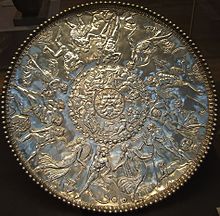Repoussé or repoussage (French pronunciation: [ʁəpuse] ( listen); [ʁəpusaʒ] (
listen); [ʁəpusaʒ] ( listen)respectively) is a metalworking technique in which a malleable metal is ornamented or shaped by hammering from the reverse side to create a design in low relief.
listen)respectively) is a metalworking technique in which a malleable metal is ornamented or shaped by hammering from the reverse side to create a design in low relief.
There are few techniques that offer such diversity of expression while still being relatively economical. Chasing is the opposite technique to repoussé, and the two are used in conjunction to create a finished piece. It is also known as embossing.
While repoussé is used to work on the reverse of the metal to form a raised design on the front, chasing is used to refine the design on the front of the work by sinking the metal. The term chasing is derived from the noun "chase", which refers to a groove, furrow, channel or indentation. The adjectival form is "chased work".
The techniques of repoussé and chasing utilise the plasticity of metal, forming shapes by degrees. There is no loss of metal in the process, as it is stretched locally and the surface remains continuous. The process is relatively slow, but a maximum of form is achieved, with one continuous surface of sheet metal of essentially the same thickness. Direct contact of the tools used is usually visible in the result, a condition not always apparent in other techniques, where all evidence of the working method is eliminated.
Contents
[hide]Etymology[edit]
The word repoussé is French and means "pushed up", ultimately from Latin: pulsare, which means "to push". Repoussage is the nounto refer to the technique, with repoussé being an adjective referring to a piece to which the technique has been applied (e.g. "repousséwork", "repoussé piece"). Chasing comes from the French word, chasser meaning to drive out, or to chase around which is what the artists are doing as they "chase" the forms on their metal in order to create their final design.
Works[edit]
【104年金工工藝人才培育計畫】
本年度研習專題以敲花技法為主,搭配鍛敲技法為輔。敲花是一種使片狀金屬呈現半浮雕造形的特殊技法,透過背面敲擊凸起成形的Repoussé與正面細節敲擊的Chasing,使圖紋躍然於金屬表面,創造出富含深淺變化的立體造形。
讓我們就從一枚金屬開始,透過對每個細節、角落毫不鬆懈的態度,體悟次次的敲擊都是有意義的感知,發現那極致精巧的躍然紋樣,其實是種凝聚龐大努力與對微小事物注入生命的深刻歷程。
研習簡章請上中心官網下載:http://www.ntcri.gov.tw



沒有留言:
張貼留言